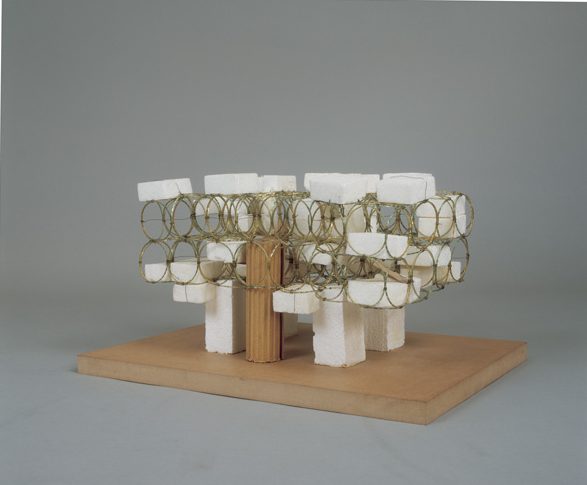Cities for the living, Yona Friedman

From September 2025 to March 2026, Frac Centre-Val de Loire is presenting an exhibition dedicated to “Mobile Architecture” theorist Yona Friedman, whose work is represented in the Frac’s collection by some thirty models and drawings.
From the 1950s, Yona Friedman developed a visionary and radical approach to architecture, rethinking its role in order to better meet the essential needs of inhabitants in a post-war context marked by numerous crises in housing, as well as in politics, economics, demographics, society and, even at that time, the environment.
Using an approach that combined urban planning and sociology, Yona Friedman championed the principle of “cities designed by their inhabitants”, which was embodied in his Spatial City project.
He proposed using movable and interchangeable modules, which could be deployed in a vertical urban development to free up land. Including housing, services, public buildings, shops, etc., Spatial Cities are designed to evolve in line with their inhabitants’ needs.
Conceived and designed according to the principles of self-planning, they also redefine the role of the architect, whose mission is now more about making assessments and supporting choices and ways of living. A new urban aesthetic would also emerge, with “a random ensemble resulting from the individual tastes of all residents”.
To support these developments, Friedman offered a varied range of training courses, tools and manuals. These manuals, produced in comic book form, would contribute to the dissemination and democratisation of the programme.
 Yona Friedman, Yona Friedman, Ville spatiale, 1959-1960. Collection Frac Centre-Val de Loire. Photo : François Lauginie, © Adagp, Paris
Yona Friedman, Yona Friedman, Ville spatiale, 1959-1960. Collection Frac Centre-Val de Loire. Photo : François Lauginie, © Adagp, ParisIn many ways, Yona Friedman’s project heralded certain approaches to architecture known as “participatory” that had already been adopted by architects and collectives convinced of the need for shared decision-making. Above all, this project echoes issues that are still very relevant, particularly with regard to ecology, democracy, social justice and even cultural policies.
Some of the structures proposed by Yona Friedman have been taken up by UNESCO and the European Union, and this exhibition offers a contemporary reinterpretation of his work and these “realisable utopias”.
The exhibition at Les Turbulences brings together models, drawings, manuals and installations from the collection of Frac Centre-Val de Loire, as well as from Frac Grand Large – Hauts-de-France (where the cneai = Friedman collection is on loan), the 49 Nord 6 Est – Frac Lorraine, Cnap / Centre national des arts plastiques and the Denise and Yona Friedman Collection.
It is organised into four main sections: Evolving Cities, Democratic Cities, Ecological Cities and Cultural Cities, which will present Le Musée sans bâtiment (The Museum Without a Building), installed in the Central Gallery (2nd floor of the Frac) and which will host proposals and creations from groups, students and citizens, either by invitation or following a public call for projects.
The exhibition design, entrusted to Morgan Fortems, is based on the principles of reuse that were so dear to Yona Friedman, to ensure it fully embodies his spirit of work and research. The exhibition also promotes a hands-on approach to this work, with access to manuals produced since 1975 for the UN, the European Union and the French Ministry of the Environment, as well as drawings and graphs displayed on the walls.
Events bringing together architects, researchers, groups and partners such as the Maison de l’Architecture et des Paysages Centre-Val de Loire will also be organised as part of the Frac’s “Nocturnes” programme.
Exhibition by Frac Centre-Val de Loire in partnership with the cneai =, Frac Grand Large – Hauts-de-France, the 49 Nord 6 Est – Frac Lorraine, Cnap / Centre national des arts plastiques, and the Fonds Denise et Yona Friedman.
